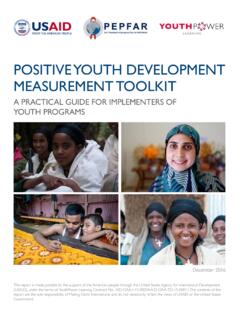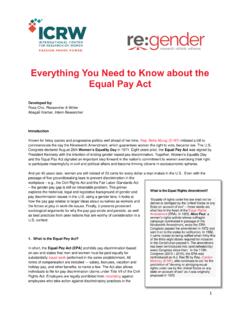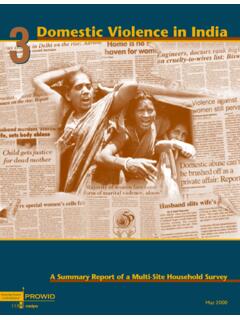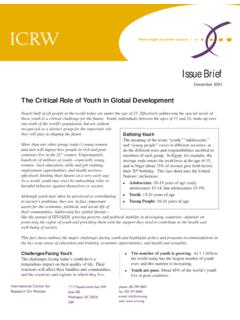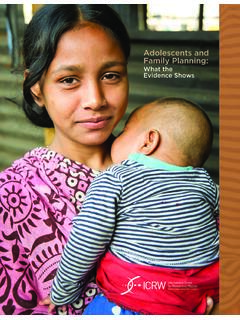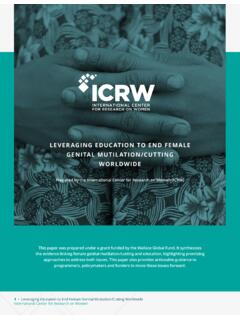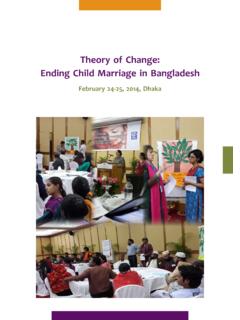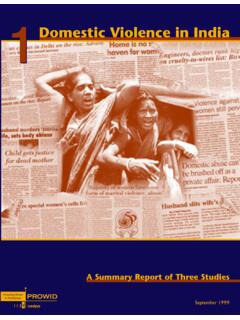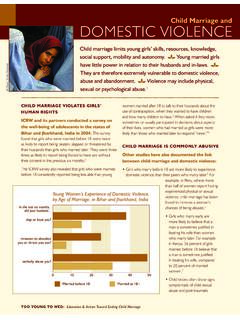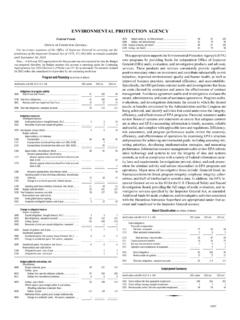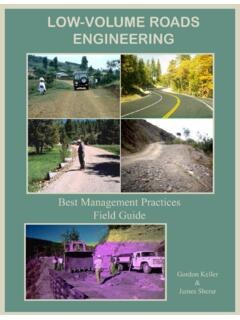Transcription of Understanding and measuring womens economic …
1 Definition, Framework and Indicatorsby Anne Marie Golla, Anju Malhotra, Priya Nanda, and Rekha MehraUnderstanding and measuring Women s economic EmpowermentDefinition, Framework and IndicatorsUnderstanding and measuring Women s economic Empowerment2 Anne Marie Golla/ICRW 2011 International Center for Research on Women (ICRW). Portions of this document may be reproduced without express permission from but with acknowledgment to ICRW gratefully acknowledges the Department of International Development (DFID), the ExxonMobil Foundation and the Bill and Melinda Gates Foundation for their generous support of this work.
2 Cover photos: David Snyder/ICRWD esign: Barbieri and GreenDefinition, Framework and Indicators3I. Introduction There is increasing recognition that eco-nomically empowering women is essential both to realize women s rights and to achieve broader development goals such as economic growth, poverty reduction, health, education and welfare. In the last five years, a broad range of organizations have com-mitted themselves to the goal of women s economic empowerment. These organiza-tions realize that economically empowering women is a win-win that can benefit not only women, but society more broadly.
3 It promotes women s ability to achieve their rights and well-being while also reducing household poverty, increasing economic growth and productivity, and increasing has found strong reasons to em-phasize women s economic empowerment in development programs: economic empowerment is one of the most powerful routes for women to achieve their potential and advance their rights. Since women make up the majority of the world s poor, meeting poverty-reduction goals requires addressing women and their economic empowerment. Discrimination against women is economi-cally inefficient.
4 National economies lose out when a substantial part of the population cannot compete equitably or realize its full potential. Working with women makes good busi-ness sense. When women have the right skills and opportunities, they can help businesses and markets grow. Women who are economically empowered contribute more to their families, societies and national economies. It has been shown that women invest extra income in their children, providing a route to sustain-able interest in fostering women s economic empowerment grows, two questions arise.
5 1. How is women s economic empowerment defined? What does the term women s economic empowerment encompass? 2. How can women s economic empower- ment be measured and evaluated so organizations can show they are on the right track to achieving it?Answers to these questions are essential to design meaningful strategies that will lead to women s economic empowerment. This document addresses them by presenting:1. A definition of women s economic empow-erment;2. A measurement framework that can guide the design, implementation and evaluation of programs to economically empower women; and3.
6 A set of illustrative indicators that can serve as concrete examples for developing meaningful metrics for concepts presented here are meant to help practitioners, researchers and donors design effective, measurable interventions to advance women economically. In develop-ing these concepts, we have drawn both on the available literature and on ICRW s direct experience in evaluating women s economic empowerment programs. This document is in-tended as a conceptual guide, rather than an operational tool kit. economic empowerment is a complex process, and the general frame-work presented here will have to be adapted to meet the needs of specific Heilman/ICRW4 Understanding and measuring Women s economic EmpowermentII.
7 Defining Women s economic Empowerment Definition: A woman is economically empowered when she has both the ability to succeed and advance economically and the power to make and act on economic decisions. To succeed and advance economically, women need the skills and resources to compete in markets, as well as fair and equal access to economic institutions. To have the power and agency to benefit from economic activities, women need to have the ability to make and act on decisions and control resources and Figure 1 illustrates, economic empow-erment is comprised of two inter-related components: 1) economic advancement and 2) power and agency .
8 Both components are connected, and both are necessary to achieve better lives for women and their families. economic gain and success ( economic advancement) promote women s power and agency . At the same time, when a woman is able to control and share in resource use (power) and to define and make choices ( agency ), she is better able to advance Addressing Women s economic EmpowermentTo achieve women s economic empower- ment , organizations must address the underlying factors that contribute to it: individual and community resources, and norms and institutions.
9 Resources are the building blocks women can draw on to succeed economically or to exercise power and agency . Resources can be at the individual or community level. They are more than financial or monetary in nature, and include: Human capital ( , education, skills, training) Financial capital ( , loans, savings) Social capital ( , networks, mentors) Physical capital ( , land, machinery)Norms and Institutions are the rules of the game or the organizational and social systems that govern activities and medi-ate relations between individuals and their social and economic environment.
10 Norms and institutions influence how resources are distributed and used. Norms include gender defined roles, taboos, prohibitions and expectations such as whether or not it is appropriate for women to be in public spaces, hold certain types of jobs, or manage money. Institutions include legal and policy structures, economic systems, market structures, marriage, inheritance and education economicgainECONOMICADVANCEMENT defineandmakechoices economicsuccessWOMEN S economic EMPOWERMENTF igure 1: Women s economic Empowerment: Two Necessary, Inter-related ComponentsAnne Marie Golla/ICRW5 Definition, Framework and IndicatorsWOMEN S economic EMPOWERMENTRESOURCESNORMSANDINSTITUTIONS POWERANDAGENCYECONOMICADVANCEMENTPROJECT EXAMPLEM icrocreditremoves constraints tofinancial resourcesthatmay allow women toadvance EXAMPLEM arket Based Approacheschange how market actorsand institutionstreatwomen and allow for theireconomic EXAMPLEL iteracy Trainingprovides a personalresourcethat boostswomen s EXAMPLEC ommunity Campaignschange social institutions(norms)
